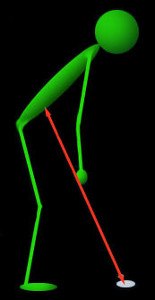

If you followed professional golf in 2011, you know that belly and long putters were all the rage. PGA Tour rookie Keegan Bradley became the first player to win a major (PGA Championship) with a longer-than-standard putter, while Adam Scott and Webb Simpson enjoyed great success as well. Even Phil Mickelson hopped on the belly putter bandwagon.
The pros notwithstanding, maybe you’re not sure you want to head down the belly/long putter road just yet. Perhaps going halfway – using one putter for practice, another for on-course play – could benefit your game?
In the case of the long putter, also called a “broomstick,” it may not be wise. At 50 inches or more, the long putter requires a completely different technique than a conventional flat stick.
On the other hand, practicing with a belly putter just might make you more effective with a standard model. At 39-43 inches, the belly putter is designed for anchoring to the golfer’s midsection, which makes it nearly impossible for the left wrist to break down during the stroke. That’s an important key regardless of your putting style.
Practicing with a belly putter may help ingrain the feeling of a solid left wrist, which should carry over when you switch back to a conventional model. Try it to groove a repeating, pendulum-like stroke.
Yes, a belly putter can be a useful training aid for improving your putting stroke and consistency. A belly putter is a putter that is longer in length and is anchored against your midsection, typically the belly or the sternum, during the stroke.
Here are a few ways a belly putter can serve as a training aid:
- Stability and Consistency: The longer length and the anchoring of the belly putter against your midsection can promote greater stability and control during the putting stroke. This can help reduce unwanted hand and wrist movement, leading to a smoother and more consistent stroke.
- Alignment and Setup: Using a belly putter can assist in establishing proper alignment and setup. By anchoring the putter against your midsection, it can help you position your eyes directly over the ball and ensure the putter face is square to the target line. This can enhance your ability to start the ball on your intended line.
- Stroke Path and Tempo: The longer length of the belly putter can help you develop a more pronounced pendulum-like swing and improve your stroke path and tempo. By allowing the putter to swing freely along the intended arc, you can develop a better sense of rhythm and timing in your putting stroke.
- Feedback and Feel: When using a belly putter, you may receive more feedback and feel for the stroke due to the extended length and contact with your midsection. This heightened feedback can help you develop a better sense of how the putter is moving throughout the stroke and make necessary adjustments to improve your mechanics.
It's important to note that the use of anchored or belly putters has been restricted in certain golfing organizations, such as the USGA and the R&A. These restrictions primarily apply to competitive play at the professional and elite amateur levels. However, they can still be used as training aids during practice and for recreational play.
As with any training aid, it's recommended to work with a golf instructor or coach who can guide you in using the belly putter effectively and help you make the necessary adjustments to your putting technique. They can provide personalized feedback and drills to optimize your use of the belly putter as a training aid and transfer those improvements to your regular putter.





